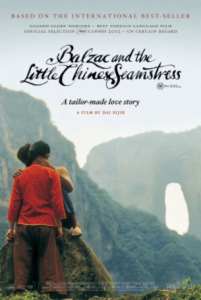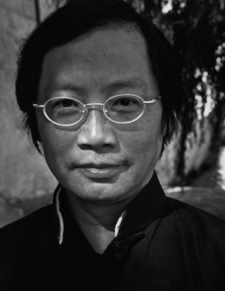– Angélica Creixell
Literature has the power to transport readers to different times in the history of a country. Rather than stating facts and chronological events, authors situate and educate readers about a reality through characterization, metaphors, settings and, essentially, the plot. A novel can be a form of expression for authors to subtly, or not so subtly, protest against historic periods or governmental regimes. It can enhance higher education by teaching indirectly through narratives and imagery. Such is the case of Dai Sijie.
Born on March 2, 1954, in Putian, China, he was sent to the Sichuan Providence for his re-education during Mao’s Cultural Revolution. Afterward, he sought refuge in France and became a filmmaker. Years later trying to succeed in this form of art, he found the magic and universality of literature. In “Balzac and the Little Chinese Seamstress,” he portrays the re-education reality of two young men, Luo, and the narrator, who are sent to the countryside to learn from illiterate farmers in a semi-autobiographic novel. Together they share the hardships of their new life and then fall in love with the same girl, a seamstress. They also meet Four Eyes, another young man from the same town who has a secret trunk full of books of Western literature – banned by the Communist regime. It is through literature that they discover the meaning of love, new ideas and the power of imagination. In the novel, literature represents freedom as it gives faith to the characters to overcome any obstacle. It becomes their channel of education in the middle of the mountains.
The novel’s subtle criticism was enough for it to be banned by the Chinese government. When talking about this, Dai Sijie stated, “It wasn’t that I touched the Cultural Revolution … they did not accept that Western literature could change a Chinese girl. I explained that classical literature is a universal heritage, but to no avail.” This novel about literature and love is an ode to the universality of literature and education. After its worldwide success, Dai Sijie directed the movie of the book. For me, it is one of the rare cases where the movie might be better than the book. As a filmmaker, Dai converts the novel’s simple language into beautiful images and palpable nostalgia as the two young men discover themselves in literature, Balzac, and love for the same seamstress. The film ends differently from the novel, as the two young men meet again in Beijing years later, possibly after completing graduate degrees in the United States and Europe, as did Dai Sijie with his former companions after the Cultural Revolution.
Sources and reviews:
Allen, Brooke. “A Suitcase Education.” The New York Times. Sept. 16, 2001. http://www.nytimes.com/2001/09/16/books/a-suitcase-education.html
Riding, Alan. “Artistic Odyssey: Film to Fiction to Film.” The New York Times. July 25, 2007. http://www.nytimes.com/2005/07/27/movies/MoviesFeatures/artistic-odyssey-film-to-fiction-to-film.html


I think this movie draws our attention to the cultural revolution’s impact on individuals. Cultural revolution resulted big delay in China’s high education system. School are closed. First time in mankind, “Knowledge” is defined as useless and evil nature of capitalism. Many young man and woman are sent to the countryside to be re-educated, which is the background of this movie. As a Chinese, I see cultural revolution as a harmful hit in education and talents in China. It froze the mind of Chinese population at that time. Not many people are lucky enough to be exposed to the outside world. Not many people are interested in the freedom, fairness and love. But the world is an open era anyway. Young scholars and students have more connections with HK and the western world. They started to have pursue of anti-corruption and willingness to participate with the politic discussion. These tendency later turns into the tragedy of 1989. I think this movie is successful demonstrating the mental and spiritual status of some young people with pioneer thinkings.
This short and beautiful novel opens a powerful reflection on the limits of public policies, which are more effective at creating incentives for the players to do something rather than at implementing bans and prohibitions. Historically, prohibitive policies have always failed. Remember this.
On a personal note, I agree with Angelica and Chaoyi : you should read the novel and watch the film, when you have time, during summer…
Thanks for introducing this film, Angelica. I saw this film several years ago when I was in Hong Kong. Yes, the theme of culture revolution is definitely sensitive in China so that I bought lots of books and saw films in Hong Kong very often at that time. The situation is much better, but still…
Anyway, back to the film. I also love the film more than the book (one important reason is because the actors, Xun Zhou, Kun Chen, and Ye Liu, are all my favorite…HAHA). My parents actually suffered a lot during the culture revolution. I was told several sad stories about their lives at that time. They were sent to the country to be “re-educated” and lost the opportunity to continue their study. When I showed the film to them, they said that a lot of young intellectuals had the fragile human ego because of the abnormal education during the culture revolution. Based on their own experience, the film was somehow unrealistic. However, I think the movie went beyond the culture revolution. Knowledge and education are essential to the social development. Any system that closes the mind to moral and intellectual truth, is evil and will prove in the end to be impotent. At the end, the narrator understood why: “It was hearing the name of Fu Lei, Balzac’s translator – someone I had never even met. It is hard to imagine a more moving tribute to the gift bestowed by an intellectual on mankind.”